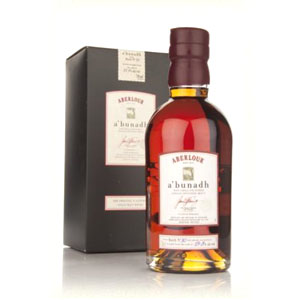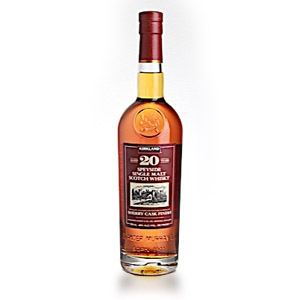
That’s it! This is my last time reviewing various forms of wood sold for the purpose of insertion into bottles to enhance/mature or otherwise influence bottled spirits. It’s a fun idea, and I’ve enjoyed the mad-scientist nature of it, but there are now enough of these products out on the market that you can read my review of Whisky Elements, Oakkits, or this one and draw your own conclusions.
Some things I’ve learned from the experience of testing various sticks:
- It is possible to leave a stick in too long, such that the spirit becomes bitter and over-oaked.
- Bourbons and ryes take longer to show an effect from oak sticks, and are changed less than lighter whiskies.
- Sticks with more end-grain have a more volatile (sometimes negative) effect.
- No stick can truly replace the effect of more time in an oak barrel.
The maker of Beyond Barrels Aging Masts contacted me with an interesting twist on the sticks-in-bottles concept: Minimize the amount of end grain while maintaining a liquid-to-wood-surface-area ratio identical to that of a 53-gallon oak barrel, heat-treat the wood without charring it (charred wood makes spirits taste like char), and then focus on adding interesting flavors through the use of French Oak (coming soon!), cherry, and even peach wood. He insisted that I not cut the sticks in half, as I’ve done with previous experiments in 375ml bottles, because that would double the ratio of end-grain to side-grain. Given that I only had three sticks and could only use three full 750ml bottles, this review can’t serve as an apples-to-apples comparison with the other products I’ve linked above. Also, I was so curious about the cherry and peach wood that I didn’t ask for any oak sticks, so apples-to-apples is right out.
Impressions and Test Procedure
Chris at Beyond Barrels was kind enough to send me three sticks to review: Two cherry wood, and one peach wood. The sticks are cylindrical and smooth, and not browned or charred, and just barely fit through the neck of a standard whiskey bottle (with an exception, see below).
I purchased full 750ml bottles of Buffalo Trace Bourbon, Bulleit Rye, and Trader Joe’s Highland Single Malt (10 year) (review upcoming). On 6/28/2015 at 6:30 PM I placed the two cherry Aging Masts in the two American whiskies and the peach Mast in the single malt. (Note: I couldn’t fit the cherry stick in the Buffalo Trace bottle, so I had to decant it into an empty (clean) glass 750ml bottle instead. I notified Beyond Barrels about this issue).
I saved “control” 50ml samples from each bottle.
Then, I tasted each whisky at 1 month, 2 months, and 3 months. At the final tasting I also compared against the controls. Feel free to skip to the bottom, with my conclusions.
TASTING ONE (7/28/2015, 4 weeks)
Trader Joe’s Highland Single Malt with Peach Aging Mast
Nary a hint of peach on the nose, but perhaps a little peach pit (marzipan). A little silkier than usual on the tongue – perhaps its been filtered a bit by the wood – flavor is slightly fruity (although it started that way), with something like mild cinnamon or stale nutmeg. Conclusion: Nothing there yet.
Bulleit Rye with Cherry Aging Mast
Definite cherry overtones – like black cherry liqueur or cherry pie filling. Rye spices remain in abundance, as well as Bulleit’s rough-and-ready frontier whiskey style. On the palate, there is an equal helping of cherry notes, plus crushed pits, roasted almonds. The palate is fiery, though, and doesn’t appear to have been “smoothed out” by the extra wood. On the finish there is a hint of fruity tannin – like red wine tannins. Conclusion: A teasing of cherry flavor, but not showing any quality improvements yet.
Buffalo Trace with Cherry Aging Mast
Again, cherry notes appear, but wrapped in a layer of brown sugar. Some of Buffalo Trace’s usual vegetal (grassy) notes have been covered or cleared up, making the aroma seem more mature. Similarly, the palate has some tart cherry and assorted wood-sugar notes (varnish, vanilla) and is missing the grassiness. Very nice. Conclusion: A marked improvement already, and some nice cherry flavors.
TASTING TWO (8/29/2015, 8 weeks)
Trader Joe’s Highland Single Malt with Peach Aging Mast
Mildly fruity on the nose – marzipan again, with maybe a hint of apple blossom or floral white tea. Silky on the tongue, and with a punched-up fruit character. Perhaps peach gummy candies, unless that’s the power of suggestion. Finishes mildly, no bitterness. Conclusion: Perhaps some slight improvement, if I search for it.
Bulleit Rye with Cherry Aging Mast
Cherry lozenge, with a lacquer-like resinous oak note right up front. This could probably now be bottled as “Bulleit Cherry Rye” (but don’t give Diageo any ideas). On the palate, a piercing tart cherry note appears and fades quickly, leaving standard rye flavors with a fruity overtone. The finish is spicy, like spiced cider. I don’t find it as hot as I did last time. Conclusion: Definite cherry character, perhaps slight improvement in quality.
Buffalo Trace with Cherry Aging Mast
A milder, subtler cherry aroma – cherry blossoms, maybe, or cherry cordial. Continuing the last tasting’s trend, Buffalo Trace’s usual grassy notes are now totally gone, thus making the apparent age (on the nose anyway) maybe 4 years older. The palate has more tannins (puckering/drying), like a red wine-finished whisky. A few bitter elements (like cocktail bitters) have begun to appear, and the palate is a bit hot this time. Conclusion: Cherry-influenced, improved apparent age, and with bitters notes making it ripe for a Old Fashioned, the stick should probably be removed now… but I want to see what a final month will do.
TASTING THREE (9/29/2015, 12 weeks) – FINAL
Trader Joe’s Highland Single Malt with Peach Aging Mast
Color: Slightly darker, with a tinge of gold.
Nose: No difference. Both have the same light profile of apple blossom, dried apple, marzipan, and beeswax. The peach stick one might have very slightly more wood sugar (syrup). Maybe.
Palate: Dried apricot. A bit of raw honey.
Finish: A ghost of cinnamon, and a tart note, like peach gummy candies. Also, the bit of acetone/paint thinner present in the original is missing.
With Water: No change noticeable with water.
Overall: A disappointing nose, but the palate is slightly improved – with a very nice wild honey character – as is the finish, which has taken on more maturity and eliminated some of the roughness in the original. Alas, not especially peach-y.
Bulleit Rye with Cherry Aging Mast
Color: Identical.
Nose: Identical, except for the faintest hint of white (Rainier) cherries.
Palate: Cherry lozenge. Heightened levels of mint, blanched almonds, cherry liqueur (Cherry Heering).
Finish: More drying (tannins), cherry candies. Quite a lot of bitters (Angostura).
With Water: Maybe a little more floral.
Overall: This one went a little too long, with a heavy dose of cocktail bitters on the finish. Still, there is a serious amount of cherry here.
Buffalo Trace with Cherry Aging Mast
Color: Very slightly darker, more reddish.
Nose: Cherry pie (not too tart), with a lot of cakey sweetness. Some degree of (medicinal) cough syrup.
Palate: Cherries, yes, but also a heavy dose of bitters, exactly like cocktail bitters (Angostura). There are less vegetal (sugar cane) notes, and more woody tannins.
Finish: Like an Old Fashioned with a few too many drops of bitters.
With Water: A few drops of water release fewer floral notes (apple blossom) in the ‘cherry’ glass.
Overall: Just like the Bulleit, this one probably went a little too long. The cherries are here, but the majority of the flavor is Angostura bitters, and the effect is nearly medicinal (cough syrup).
Conclusion
Surprisingly for me, the peach stick was a bust. I would have thought that the lightness and “blank slate” (ex-bourbon cask aging) of the single-malt would show nicely with the peach, but the effect was minimal and certainly wouldn’t have been worth paying $10 for the stick, if I hadn’t gotten them for free. 🙂 I am happy to report that at exactly two months of aging, both the Buffalo Trace and the Bulleit Rye were markedly improved (quality-wise) by the cherry Masts, AND had a double dose of slightly bitter cherry fruit flavor imparted by the wood. I would suggest drinking through the bottle at this point (quickly), or decanting the bottle to remove the stick. The final month of maturation extracted too many bitter flavors from the wood. Luckily, this whiskey is still good for cocktails.
Speaking of cocktails, I was curious if the bitter flavors at three months could replace bitters in an Old Fashioned or Manhattan, so I made one of each (Buffalo Trace in the Old Fashioned, Bulleit Rye in the Manhattan) without bitters. While I could definitely tell that the drinks were “bittered”, the effect was not sufficient to fully replace bitters in the recipe. Someday I may have to try Chris’s recipe for a “Mast-Aged” bottled Manhattan.
Should you buy these sticks? I would say that if you’re curious (or are looking for a gift for a whiskey-drinker), go for the cherry sticks and limit aging to two months (or taste frequently after two months). I think the effects were more interesting and less volatile than Whiskey Elements, and were slightly more interesting (and less mess) than the Oakkits. This goes double if the idea of putting bourbon into cherrywood barrels floats your boat.
What do you think about sticking oak sticks in bottles? Any experiences to share? Comment below!






This really sounds like something to try with a low tier whiskey. I’m interested in seeing what you think of with the other aging option out there, that of using miniature oak casks for quick aging. I was gifted a 5 Liter cask and aged red wine for 6 weeks, with a very noticable change. I just finished aging a bottom shelf bourbon in the same cask, hoping to pick up some of that red wine flavors. Are you planning on attempting this form of aging?
Hi Jarod,
I’ve thought about it, but I can’t afford to do multiple small casks for comparison’s sake, so I’ve been holding off. Someday!
Hey,
You can definitely use this product with lower tier whiskeys as well. You can make a bad whiskey good, or a good whiskey great. I wouldn’t use it on a masterpiece like pappy etc, that would be blasphemy. I have had very good results with products as high end as blantons and 4r single barrel.
One of the keys to getting good results from aging is to get the ratio of wood surface area to liquid volume right. 53 gallon casks produce the best results due to this ratio being ideal. Smaller barrels produce inferior results because the wood flavors overpower everything before the slow aging chemical and biological reactions can take place. The product in the article has the same ratio of wood to liquid as a 53 gallon cask.
How did you fish out the staves afterwards?
I believe I “decanted” the liquid into another bottle and then let the stick dry so it could slip out easily. They do swell a little bit while wet.